Day One
Lunch
After a harrowing crossing from the port town of Tangier, we finally made it into Spain and arrived in Seville, the capital of Andalucia and famous for flamenco, bull-fighting and tapas. It was, of course, with tapas that we were primarily concerned, and our first lunch was a small tapas joint called Las Coloniales (19 Plaza Cristo de Burgos), which turned out to have the cheapest tapas in all of Seville.
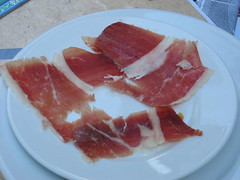
The only problem was that we didn’t speak any Spanish, and the waiter didn’t speak any English. Deciding to start with something familiar, I ordered a plate of jamón iberico, or cured Serrano ham, Spain’s equivalent of Parma’s famous prosciutto. As I enjoyed the thin, silky slices, we pondered on what else to order, and decided to simply point at what other people were ordering.
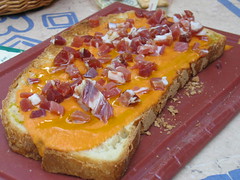
This proved to be a useful tactic, as our next serving, salmorejo con jamón, turned out to be superb. Salmorejo is generally a soup made from fresh tomatoes and breadcrumbs, rather like a chunky gazpacho, but here it was made into a spread and slathered across a crusty slice of bread, topped with diced ham and olive oil. Amazingly sweet and refreshing, we were astonished to find salmorejo costing five times more in other restaurants. Thankfully we stumbled onto such a good deal early into our Spanish leg.
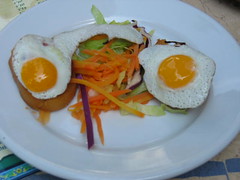
I felt like having some Spanish chorizo, so I randomly pointed at another selection, huevos de codorniz con chorizo, and again was very happy with the result. Little fried quail’s eggs sitting atop a sliced Spanish sausage, beneath which was a toasted crostini, these bite-sized morsels were the perfect starter to any meal. The eggs were perfect sunny-side-ups, with the rich yolks running unctuously as you bit into them.
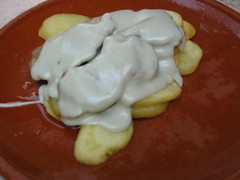
Next we had solomillo al Roquefort, tender steak slices covered in a thick sauce enriched with roquefort cheese, served over roasted potatoes. The strong sauce was an excellent pairing, adding an extra dimension to the meat without overpowering it, and helped to give the potatoes some depth of flavour.
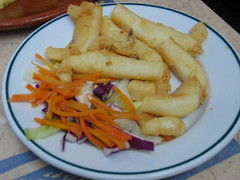
Running out of options as to what to order, we pointed at the recommendation of the day, which turned out to be fried squid. Unlike typical fried calamari, this did not taste like rubber, but was perfectly cooked – succulent and firm, but providing just the right amount of resistance before yielding to the bite.
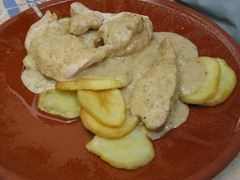
Our last order was pechuga de pollo con salsa de almendras, chicken breast sauced with a mild pepper cream sauce. This was fairly unremarkable, and was a comfortable end to our excellent and extremely affordable meal.
Dinner
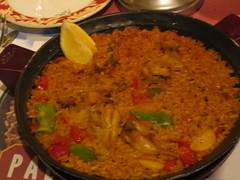
Although Valencia is the home of paella, it is possible to find paella dishes in Seville; they just tend not to be very good ones. Dinner was a plate of paella cooked with chicken and peppers, but I found little in it to be enthused about and was already looking forward to the next tapas meal.
Day Two
Lunch
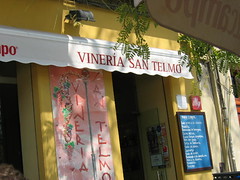
We were recommended to try the tapas at Vineria San Telmo at 4, Paseo Catalina de Ribera, and we discovered they offered a five-course tapas degustation menu for €16, which we decided to go for. The idea of a tapas degustation seems like a redundancy, but it is clear that San Telmo is a modern tapas bar that does not hesitate in departing from convention.
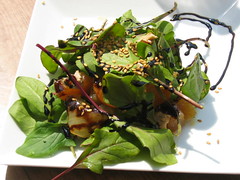
We started with a red spinach salad, dusted with sesame seeds and sherry vinegar, matched with quince jelly and marinated quail. The quince was an unusual addition, tasteless but for subtle undertones of sweetness, and as quail is not a very strong-tasting meat, the most distinct flavours were the vinegar and sesame.
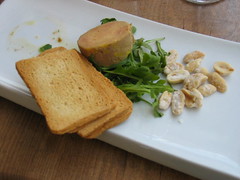
Our next course was homemade foie gras mi-cuit in vanilla oil, served on a bed of arugula leaves and frosted peanuts. While the foie gras was faultless, smooth and rich as foie should be, the overall impression of the dish was one of sweetness. The vanilla, in lending a perfumed fragrance, also over-emphasised the sweetness of the frosted peanuts. A better option might have been to balance the richness of the dish with a tart sauce or salted rather than frosted peanuts.
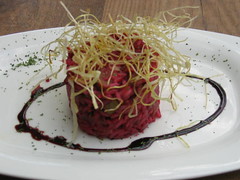
Food that is visually impressive always seems to taste better, if only because the sensory appeal of the food’s aesthetic presentation compensates for a deficiency in the other smell and taste departments. Whatever the reason, I quite enjoyed our basmati rice cooked with beet root and mushrooms, decorated with a nest of dried shallots. The grains of rice were plump and firm, and the beet root dyed them a deep rose hue, enhancing the overall sex appeal of the dish.
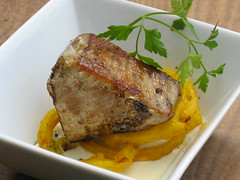
Next was a tuna fillet with tempura rings on a garlic ajo blanco sauce. The trout was cooked to perfection, the outside skin seared and slightly crisp while the inside was still reddish-pink and meaty. The crunchy tempura and the creamy mayonnaise-like sauce provided contrasting textures and an inventive mix of flavours.
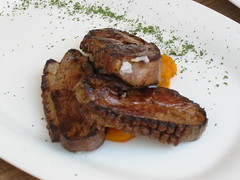
I ended with a seared duck breast paired with pumpkin purée, which was mildly disappointing after the creativeness of the earlier courses, but was undoubtedly well-executed and reflected the chef’s solid grasp of more traditional cuisine. Overall, the meal at San Telmo was rewarding and reminded me of the many facets of Spanish gastronomy, and its unbridled willingness to explore the boundaries of modern Spanish food.
Tea
One of the best things about Spain is their treatment of chocolate. While I’ve always been a fan of hot chocolate, most of the time the hot chocolate you receive in cafes is only barely drinkable, and is a disgusting parody of what true hot chocolate should be.
Pierre Hermé provides an excellent recipe for chocolat chaud à l’ancienne in his book on chocolate desserts, but even in Paris too many cafes sell you the anglicised version of hot chocolate; watered down and made from second-rate chocolate powder, rather than give you the real stuff – pure melted chocolate mixed with small amounts of either milk or water.
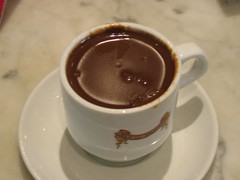
In Spain, they take their hot chocolates seriously – very thick and very sweet. My first hot chocolate was in fact a hot chocolate sauce, and quite literally could have been used to coat strawberries. While even I found this too cloying, I was greatly appreciative of the Spaniards’ respect of what a proper chocolate drink should be like.
Subsequently, I enjoyed rich, luxurious hot chocolates in several bars and cafeterias across Andalucia, including a Ben and Jerry’s outlet in Granada. One memorable experience was churros con chocolate, a traditional breakfast of hot chocolate accompanied by fried fritters, rather like the you tiao that accompanies Chinese porridge.
Day Three
Lunch
Sadly, many of our meals, because we didn’t know where to go, tended to be unrepresentative of true Spanish cuisine, more often than not the stuff only tourists would get.

Case in point, a restaurant in Ronda where I had a gazpacho, which was decent enough, since it’s quite difficult to mangle what is essentially tomato juice with added ingredients.
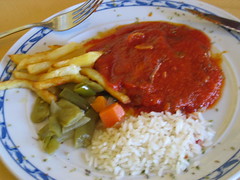
My main course pork fillet done in the traditional style though, was nothing more than a tasteless piece of pork disguised with a tart tomato sauce, served with a measly amount of rice, fries, and very oily vegetables.
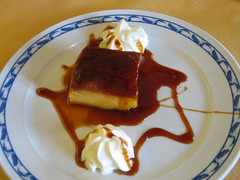
Even dessert, what should have been an enjoyable crème Catalan, tasted more like a very sweet jelly drowned in a caramel sauce. As in everywhere else, the bad food tends to outnumber the good, unless you’re in the know or happen to be exceptionally lucky.
Day Four
Lunch
Arriving in Granada, we tried to look for some tapas for lunch, but the concept of tapas was somewhat different in Granada; being a small portion of food that arrived free with a drink you ordered, rather than an assortment of small dishes you could order on their own.
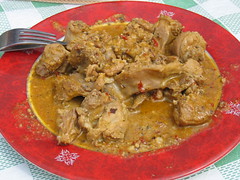
Seeing rabbit on the menu, I decided to order it. The resulting dish, a hearty stew served with a rich sauce heavily laced with garlic, tasted just like chicken, but with many more bones. I suspect rabbit is not more commonly eaten because of just how troublesome it is to eat – more time was spent picking off the bones than picking off the meat.
Dinner
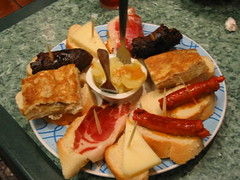
We decided the best way to have a tapas meal was to order the surtido de tapas, or assortment of tapas, from different bars. Tapas in Granada tends to be more coarse than its Sevillian counterparts, our first assortment was merely cheeses, sausages and ham atop slices of bread. It’s entirely possible that’s what tapas started off as, but something slightly more updated would have been appreciated.
Day Five
Dinner

Our misfortune continued the next day, as a €14 plate turned out not to be an assortment of tapas, but a selection of meats: mainly chorizo, with some ham, cheeses, paté and pork. These might have been nice paired with crostini or crackers, drizzled with some olive oil or sweet vinegar, but on their own they were somewhat dry and dismal.
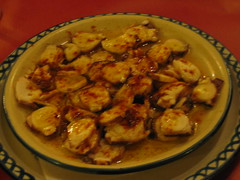
Still hungry, we went in search of pulpo a la gallega, a Spanish dish of cooked octopus. When we finally found it, I didn’t think much of it, as the taste of the white wine garlic sauce seemed to mask the flavour of the seafood.
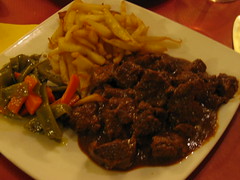
I also had a venison stew as part of my main course, cooked in a rich red wine sauce. Venison lends itself particularly well to stews, as it is more full-bodied than beef, and doesn’t become tough and stringy as easily.
Day Six
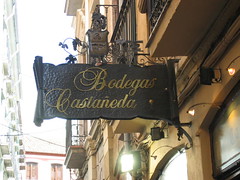
Lunch on our final day was at Bodegas Castaneda (5, Calle de Elvira), this tourist-accredited tavern that does a roaring business in Granada.
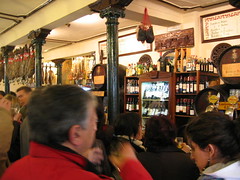
We’d seen how crowded it was the night before, and the food it served looked good, so we decided to order some tapas and hope for the best.
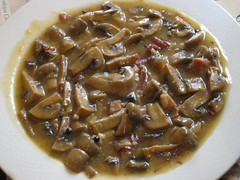
We first had an interesting broth of mushrooms and diced ham. The resulting mix was both earthy and meaty, but fairly salty from the addition of the cured ham. Fortunately there was bread on hand to soak up the sauce and offset the saltiness.
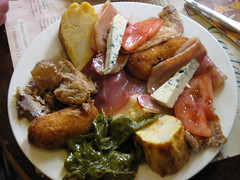
The plato Caliente was an assortment of ham, bacon, croquettes, pepper skins, tortilla, cheese and turkey breast, an extremely filling assortment that was hearty and characteristic of the bar food in Granada which, while lacking in sophistication, made up in quantity and taste.



No comments:
Post a Comment